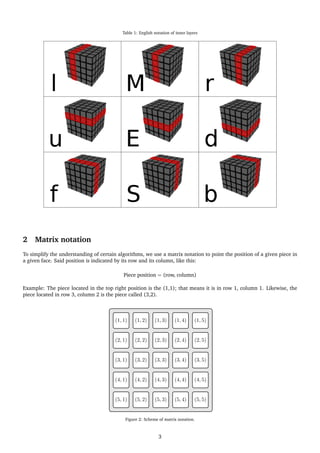5x5x5 notation (english)
- 1. Ibero Rubik 5x5x5 cube: Notation Version 1. Updated on 17th August 2016.
- 2. 1 Parts of the cube 1.1 Faces Faces are the plane surfaces that contain 25 stickers. There are 6 faces. Figure 1: English notation of faces. 1.2 Centres, edges and corners Centres Edges Corners For us, centres are not the central pieces of each face, but the central 3x3-sticker surfaces that define the colour of every face. There are 6 centres, with 9 stickers each. Likewise, we call edge to the three-piece group, with two stickers each. There are 12 edges in the cube. Corners are the pieces containing 3 stickers. There are 8 corners. 1.3 Inner layers They are named the same way as the faces but with lower case letters (except for M, E y S layers, which are upper case because there can be no confusion with other layers). 2
- 3. Table 1: English notation of inner layers 2 Matrix notation To simplify the understanding of certain algorithms, we use a matrix notation to point the position of a given piece in a given face. Said position is indicated by its row and its column, like this: Piece position = (row, column) Example: The piece located in the top right position is the (1,1); that means it is in row 1, column 1. Likewise, the piece located in row 3, column 2 is the piece called (3,2). (1, 1) (1, 2) (1, 3) (1, 4) (1, 5) (2, 1) (2, 2) (2, 3) (2, 4) (2, 5) (3, 1) (3, 2) (3, 3) (3, 4) (3, 5) (4, 1) (4, 2) (4, 3) (4, 4) (4, 5) (5, 1) (5, 2) (5, 3) (5, 4) (5, 5) Figure 2: Scheme of matrix notation. 3
- 4. 3 Turns and rotations of the whole cube In the following pictures, red arrows inicate clockwise turns and blue arrows indicate counterclockwise turns. Turns of outer layers Turns of inner layers Turns of inner and outer layers at same time To indicate a clockwise turn, the letter of the face is written. Example: R To indicate a clockwise turn, the letter of the face and an apostrophe are written. Example: R’ To indicate a double turn, the letter of the face and a number 2 are written. Example: R2 The turns of inner layers are indicated just like the outer layers, but using lower case letters. Examples: Clockwise turn: r Counterclockwise turn: r’ Double turn (180◦ ): r2 We can also turn both the inner and the outer layer at the same time; this is indicated with the upper case and the lower case letters in brackets. Examples: Clockwise turn: (Rr) Counterclockwise turn: (Rr)’ Double turn (180◦ ): (Rr)2 As for the rotations of the whole cube, they are indicated with letters x, y and z as follows: • Just the letter if it is a clockwise turn. Example: x • The letter and an apostrophe if it is a counterclockwise turn. Example: z • The letter and a number 2 if it is a double turn. Example: y2 Figure 3: Rotations of the whole cube. 4
- 5. This guide and much more at: www.iberorubik.com





